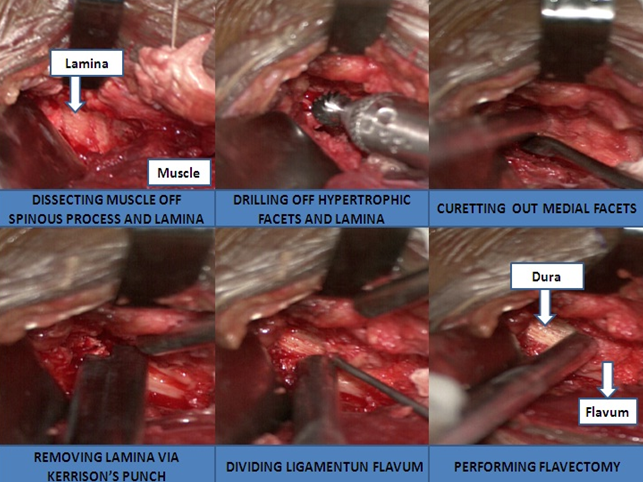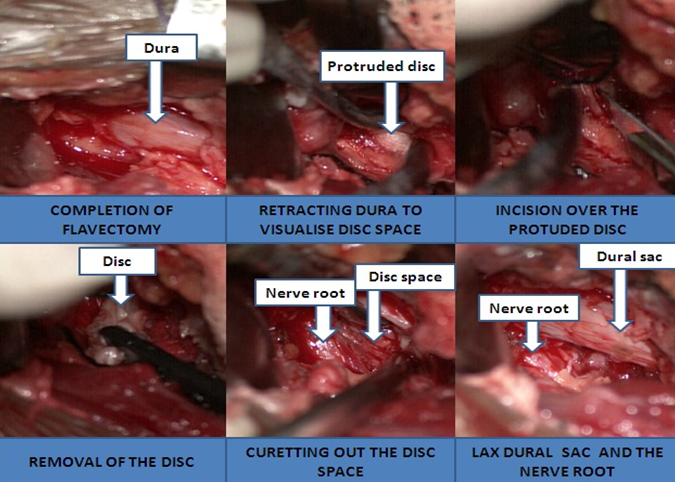[1]
Shakya A, Sharma A, Singh V, Rathore A, Garje V, Wadgave V, Kakadiya G, Marathe N. Preoperative Lumbar Epidural Steroid Injection Increases the Risk of a Dural Tear During Minimally Invasive Lumbar Discectomy. International journal of spine surgery. 2022 Jun:16(3):505-511. doi: 10.14444/8249. Epub
[PubMed PMID: 35772973]
[2]
Vialle LR,Vialle EN,Suárez Henao JE,Giraldo G, LUMBAR DISC HERNIATION. Revista brasileira de ortopedia. 2010 Jan;
[PubMed PMID: 27019834]
[3]
Ma D, Liang Y, Wang D, Liu Z, Zhang W, Ma T, Zhang L, Lu X, Cai Z. Trend of the incidence of lumbar disc herniation: decreasing with aging in the elderly. Clinical interventions in aging. 2013:8():1047-50. doi: 10.2147/CIA.S49698. Epub 2013 Aug 7
[PubMed PMID: 23966775]
[5]
Gopal VV. Degenerative Lumbar Disc Disease: A Questionnaire Survey of Management Practice in India and Review of Literature. Journal of neurosciences in rural practice. 2021 Jan:12(1):159-164. doi: 10.1055/s-0040-1722103. Epub 2021 Jan 29
[PubMed PMID: 33531776]
Level 3 (low-level) evidence
[6]
Koebbe CJ,Maroon JC,Abla A,El-Kadi H,Bost J, Lumbar microdiscectomy: a historical perspective and current technical considerations. Neurosurgical focus. 2002 Aug 15;
[PubMed PMID: 15916400]
Level 3 (low-level) evidence
[7]
Weinstein JN,Tosteson TD,Lurie JD,Tosteson AN,Hanscom B,Skinner JS,Abdu WA,Hilibrand AS,Boden SD,Deyo RA, Surgical vs nonoperative treatment for lumbar disk herniation: the Spine Patient Outcomes Research Trial (SPORT): a randomized trial. JAMA. 2006 Nov 22;
[PubMed PMID: 17119140]
Level 1 (high-level) evidence
[8]
Weinstein JN,Lurie JD,Tosteson TD,Skinner JS,Hanscom B,Tosteson AN,Herkowitz H,Fischgrund J,Cammisa FP,Albert T,Deyo RA, Surgical vs nonoperative treatment for lumbar disk herniation: the Spine Patient Outcomes Research Trial (SPORT) observational cohort. JAMA. 2006 Nov 22;
[PubMed PMID: 17119141]
[9]
Postacchini F,Postacchini R, Operative management of lumbar disc herniation : the evolution of knowledge and surgical techniques in the last century. Acta neurochirurgica. Supplement. 2011;
[PubMed PMID: 21107933]
[10]
Caspar W,Campbell B,Barbier DD,Kretschmmer R,Gotfried Y, The Caspar microsurgical discectomy and comparison with a conventional standard lumbar disc procedure. Neurosurgery. 1991 Jan;
[PubMed PMID: 1994285]
[11]
Williams RW, Microlumbar discectomy: a conservative surgical approach to the virgin herniated lumbar disc. Spine. 1978 Jun;
[PubMed PMID: 663769]
[12]
Calikoglu C,Cakir M, Open Discectomy vs. Microdiscectomy: Results from 519 Patients Operated for Lumbar Disc Herniation. The Eurasian journal of medicine. 2018 Oct;
[PubMed PMID: 30515039]
[13]
Kahanovitz N,Viola K,Muculloch J, Limited surgical discectomy and microdiscectomy. A clinical comparison. Spine. 1989 Jan;
[PubMed PMID: 2913673]
[14]
Vucetic N,de Bri E,Svensson O, Clinical history in lumbar disc herniation. A prospective study in 160 patients. Acta orthopaedica Scandinavica. 1997 Apr;
[PubMed PMID: 9174445]
[15]
Katayama Y,Matsuyama Y,Yoshihara H,Sakai Y,Nakamura H,Nakashima S,Ito Z,Ishiguro N, Comparison of surgical outcomes between macro discectomy and micro discectomy for lumbar disc herniation: a prospective randomized study with surgery performed by the same spine surgeon. Journal of spinal disorders
[PubMed PMID: 16826006]
Level 1 (high-level) evidence
[16]
Weber H, Lumbar disc herniation. A controlled, prospective study with ten years of observation. Spine. 1983 Mar;
[PubMed PMID: 6857385]
[17]
Quinlan JF,Duke D,Eustace S, Bertolotti's syndrome. A cause of back pain in young people. The Journal of bone and joint surgery. British volume. 2006 Sep;
[PubMed PMID: 16943469]
[18]
Zhong M, Liu JT, Jiang H, Mo W, Yu PF, Li XC, Xue RR. Incidence of Spontaneous Resorption of Lumbar Disc Herniation: A Meta-Analysis. Pain physician. 2017 Jan-Feb:20(1):E45-E52
[PubMed PMID: 28072796]
Level 1 (high-level) evidence
[19]
Plasencia Arriba MÁ,Maestre C,Martín-Gorroño F,Plasencia P, Analysis of Long-Term Results of Lumbar Discectomy With and Without an Interspinous Device. International journal of spine surgery. 2022 Jul 31;
[PubMed PMID: 35908809]
[20]
Jaiswal A,Kumar S,Reddy S,Jaiswal P, Feasibility and Safety of Outpatient Lumbar Microscopic Discectomy in a Developing Country. Asian spine journal. 2019 Oct;
[PubMed PMID: 31154705]
Level 2 (mid-level) evidence
[21]
Desai A,Ball PA,Bekelis K,Lurie JD,Mirza SK,Tosteson TD,Weinstein JN, Outcomes after incidental durotomy during first-time lumbar discectomy. Journal of neurosurgery. Spine. 2011 May;
[PubMed PMID: 21375385]
[22]
Vangen-Lønne V,Madsbu MA,Salvesen Ø,Nygaard ØP,Solberg TK,Gulati S, Microdiscectomy for Lumbar Disc Herniation: A Single-Center Observational Study. World neurosurgery. 2020 Feb 17;
[PubMed PMID: 32081830]
Level 2 (mid-level) evidence
[23]
Kogias E,Klingler JH,Franco Jimenez P,Vasilikos I,Sircar R,Scholz C,Hubbe U, Incidental Durotomy in Open Versus Tubular Revision Microdiscectomy: A Retrospective Controlled Study on Incidence, Management, and Outcome. Clinical spine surgery. 2017 Dec;
[PubMed PMID: 29176490]
Level 2 (mid-level) evidence
[24]
Shriver MF,Xie JJ,Tye EY,Rosenbaum BP,Kshettry VR,Benzel EC,Mroz TE, Lumbar microdiscectomy complication rates: a systematic review and meta-analysis. Neurosurgical focus. 2015 Oct;
[PubMed PMID: 26424346]
Level 1 (high-level) evidence
[25]
Shimia M,Babaei-Ghazani A,Sadat BE,Habibi B,Habibzadeh A, Risk factors of recurrent lumbar disk herniation. Asian journal of neurosurgery. 2013 Apr;
[PubMed PMID: 24049552]
[26]
Camino Willhuber G,Kido G,Mereles M,Bassani J,Petracchi M,Elizondo C,Gruenberg M,Sola C, Factors associated with lumbar disc hernia recurrence after microdiscectomy. Revista espanola de cirugia ortopedica y traumatologia. 2017 Nov - Dec;
[PubMed PMID: 28899699]
[27]
Weiner BK,Kilgore WB, Bacterial shedding in common spine surgical procedures: headlamp/loupes and the operative microscope. Spine. 2007 Apr 15;
[PubMed PMID: 17426639]
[28]
Tronnier V,Schneider R,Kunz U,Albert F,Oldenkott P, Postoperative spondylodiscitis: results of a prospective study about the aetiology of spondylodiscitis after operation for lumbar disc herniation. Acta neurochirurgica. 1992;
[PubMed PMID: 1414515]
[29]
Basques BA,Golinvaux NS,Bohl DD,Yacob A,Toy JO,Varthi AG,Grauer JN, Use of an operating microscope during spine surgery is associated with minor increases in operating room times and no increased risk of infection. Spine. 2014 Oct 15;
[PubMed PMID: 25188600]
[30]
Tsitsopoulos PP. Accidental dural tear in lumbar spine surgery. Acta neurochirurgica. 2022 Jul:164(7):1889-1890. doi: 10.1007/s00701-022-05262-2. Epub 2022 Jun 1
[PubMed PMID: 35648214]
[31]
Charalambous LT, Rajkumar S, Liu B, Adil SM, Wong M, Hodges S, Amrhein TJ, Leithe LG, Parente B, Lee HJ, Lad SP. Treatment Patterns and Health Care Resource Utilization of Iatrogenic Spinal Cerebrospinal Fluid Leaks in the United States. Clinical spine surgery. 2022 Nov 1:35(9):E725-E730. doi: 10.1097/BSD.0000000000001363. Epub 2022 Jul 14
[PubMed PMID: 35858207]
[32]
Asan Z. Early Postoperative Iatrogenic Neuropraxia After Lumbar Disc Herniation Surgery: Analysis of 87 Cases. World neurosurgery. 2023 Feb:170():e801-e805. doi: 10.1016/j.wneu.2022.11.128. Epub 2022 Nov 30
[PubMed PMID: 36460197]
Level 3 (low-level) evidence
[33]
Hasan GA, Qatran Raheem H, Yuser A, Al-Naser LM, Sheta RA. Vascular injury in tubular lumbar microdiscectomy, case report and literature review. SAGE open medical case reports. 2019:7():2050313X19851695. doi: 10.1177/2050313X19851695. Epub 2019 May 26
[PubMed PMID: 31205717]
Level 3 (low-level) evidence
[35]
Mariscal G, Torres E, Barrios C. Incidence of recurrent lumbar disc herniation: A narrative review. Journal of craniovertebral junction & spine. 2022 Apr-Jun:13(2):110-113. doi: 10.4103/jcvjs.jcvjs_38_22. Epub 2022 Jun 13
[PubMed PMID: 35837428]
Level 3 (low-level) evidence
[36]
Guo J, Li G, Ji X, Wu X, Zhang G, Zhou C, Ma X. Clinical and Radiological Risk Factors of Early Recurrent Lumbar Disc Herniation at Six Months or Less: A Clinical Retrospective Analysis in One Medical Center. Pain physician. 2022 Oct:25(7):E1039-E1045
[PubMed PMID: 36288589]
Level 2 (mid-level) evidence
[37]
Abdallah A, Güler Abdallah B. Factors associated with the recurrence of lumbar disk herniation: non-biomechanical-radiological and intraoperative factors. Neurological research. 2023 Jan:45(1):11-27. doi: 10.1080/01616412.2022.2116525. Epub 2022 Sep 1
[PubMed PMID: 36047564]
[38]
Huang W, Han Z, Liu J, Yu L, Yu X. Risk Factors for Recurrent Lumbar Disc Herniation: A Systematic Review and Meta-Analysis. Medicine. 2016 Jan:95(2):e2378. doi: 10.1097/MD.0000000000002378. Epub
[PubMed PMID: 26765413]
Level 1 (high-level) evidence
[39]
Fandiño J, Botana C, Viladrich A, Gomez-Bueno J. Reoperation after lumbar disc surgery: results in 130 cases. Acta neurochirurgica. 1993:122(1-2):102-4
[PubMed PMID: 8333299]
Level 3 (low-level) evidence
[40]
Wang H, Wang S, Yu H, Chen Y, Zheng L, Ma J. Surgical treatment of recurrent postoperative discal pseudocyst: A case report and literature review. Medicine. 2022 Nov 11:101(45):e31756. doi: 10.1097/MD.0000000000031756. Epub
[PubMed PMID: 36397328]
Level 3 (low-level) evidence
[41]
Naouli H, Jiber H, Bouarhroum A. Iliac arteriovenous fistula following lumbar disc surgery. A case report. Journal de medecine vasculaire. 2022 Oct:47(4):199-202. doi: 10.1016/j.jdmv.2022.09.004. Epub 2022 Oct 23
[PubMed PMID: 36344032]
Level 3 (low-level) evidence
[42]
Wu S, Bu W, Wu D, Du J. Spontaneous absorption of lumbar epidural hematoma after percutaneous endoscopic lumbar discectomy in a patient with lumbar disc herniation. Asian journal of surgery. 2023 Feb:46(2):880-881. doi: 10.1016/j.asjsur.2022.07.067. Epub 2022 Aug 8
[PubMed PMID: 35953362]
[43]
Shyam K, Bhari Thippeswamy P, Shetty AP, Algeri R, Rajasekaran S. Gauze for concern: A Case Report and systematic review of delayed presentation of paraspinal textiloma. Journal of clinical orthopaedics and trauma. 2022 Sep:32():101967. doi: 10.1016/j.jcot.2022.101967. Epub 2022 Aug 14
[PubMed PMID: 36051862]
Level 3 (low-level) evidence
[44]
Weinstein JN,Lurie JD,Tosteson TD,Tosteson AN,Blood EA,Abdu WA,Herkowitz H,Hilibrand A,Albert T,Fischgrund J, Surgical versus nonoperative treatment for lumbar disc herniation: four-year results for the Spine Patient Outcomes Research Trial (SPORT). Spine. 2008 Dec 1;
[PubMed PMID: 19018250]
[45]
Lurie JD,Tosteson TD,Tosteson AN,Zhao W,Morgan TS,Abdu WA,Herkowitz H,Weinstein JN, Surgical versus nonoperative treatment for lumbar disc herniation: eight-year results for the spine patient outcomes research trial. Spine. 2014 Jan 1;
[PubMed PMID: 24153171]
[46]
Rasouli MR,Rahimi-Movaghar V,Shokraneh F,Moradi-Lakeh M,Chou R, Minimally invasive discectomy versus microdiscectomy/open discectomy for symptomatic lumbar disc herniation. The Cochrane database of systematic reviews. 2014 Sep 4;
[PubMed PMID: 25184502]
Level 1 (high-level) evidence
[47]
Clark AJ,Safaee MM,Khan NR,Brown MT,Foley KT, Tubular microdiscectomy: techniques, complication avoidance, and review of the literature. Neurosurgical focus. 2017 Aug;
[PubMed PMID: 28760036]
[48]
Arts MP,Brand R,van den Akker ME,Koes BW,Bartels RH,Peul WC, Tubular diskectomy vs conventional microdiskectomy for sciatica: a randomized controlled trial. JAMA. 2009 Jul 8;
[PubMed PMID: 19584344]
Level 1 (high-level) evidence
[49]
Lee P,Liu JC,Fessler RG, Perioperative results following open and minimally invasive single-level lumbar discectomy. Journal of clinical neuroscience : official journal of the Neurosurgical Society of Australasia. 2011 Dec;
[PubMed PMID: 21944927]
[50]
Lau D,Han SJ,Lee JG,Lu DC,Chou D, Minimally invasive compared to open microdiscectomy for lumbar disc herniation. Journal of clinical neuroscience : official journal of the Neurosurgical Society of Australasia. 2011 Jan;
[PubMed PMID: 20851604]
[51]
Bombieri FF, Shafafy R, Elsayed S. Complications associated with lumbar discectomy surgical techniques: a systematic review. Journal of spine surgery (Hong Kong). 2022 Sep:8(3):377-389. doi: 10.21037/jss-21-59. Epub
[PubMed PMID: 36285095]
Level 1 (high-level) evidence


